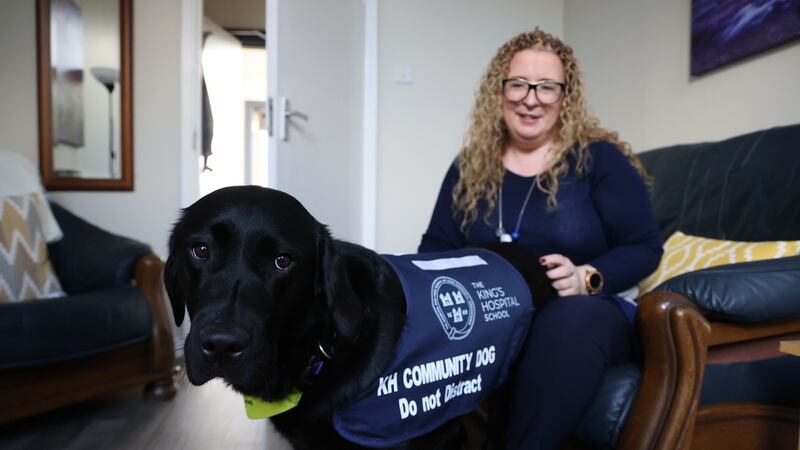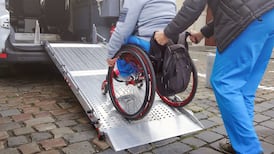It's just before the end of term in King's College Hospital and we are in the staff room, on a break between morning classes. Everyone is looking for biscuits. Not all of them have two legs. Nala, a black Labrador, knows that there are biscuits in a bag that staff member Clair Breen is carrying with her, and she wants some. So the dog sits and waits until one duly appears.
Breen is the school’s psychotherapist and wellbeing co-ordinator. Nala is the school’s community dog; on campus since September of last year. She lives with Breen when out of school hours, and has a bed in Breen’s office during the day.
"It's a pilot project," Breen explains. Nala has been leased to the school by the Irish Guide Dogs for the Blind (IGD). The IGD train 30 guide dogs and 40 assistant dogs a year. The assistant dogs go to the families of children who are living with autism. The IGD are now in the process of trialling community dogs in schools. Three schools to date have received dogs. Travis is in St Peter's College in Dunboyne, Co Meath; Teal is in St Raphael's in Loughrea, Go Galway; and Nala is here in Dublin's Kings College.
"Everyone knows Nala, and everyone knows Ciara is 'the lady with the dog'," special education teacher Gracie Bill explains. While not every student may have been previously aware of Breen – King's has 710 students, including 278 boarders – they now all know her. Breen's increased visibility in the school corridors, due to the distinctive Nala trotting alongside, has also raised awareness of the job she does. The prospect of accessing therapy is easier to figure out and less daunting to do when the therapist comes with the school's own community high-profile dog.
“I’m not a dog person,” admits Bill, cheerfully, to me, when Nala is safely out of earshot. “But just to watch the response from students when Clair is walking with her is amazing.” Nala wears a coat with a message that reads she’s working, and not to be distracted, in the same way guide dogs do. Students must first ask Breen if they can pet her should they meet on the corridors, so the dog doesn’t get overwhelmed.
Some of Bill’s students have availed of Breen’s services as a therapist. “I have seen the level of anxiety rising and rising and rising among young people this last year,” she says. “The dog allows young people to open up. It helps with the first step of starting to talk. A dog changes the atmosphere in a room.”
Breen’s office is a sunny corner room, with a sofa, some armchairs, and a large dog bed near her desk. “The dog helps break the barrier,” she says. “Coming to see me is less stigmatising now that Nala is here.”
Nala flops down in her bed, keeping an eye on Breen. The IGD own her, even though Breen is the person who has agreed to be the dog’s designated minder. The school cover the cost of food, any veterinary treatment, and general upkeep. Nala also has another room she can go to with a beanbag, and toys, and where nobody goes, to give her a rest. “She’s the only member of staff with two offices,” Breen quips.
Students make an appointment to see Breen, and if a series of therapy sessions then follow, their parents are informed. “But I tell the students that even though their parents know they are seeing me, what we say together in the rooms is confidential. One student came in who was having a panic disorder due to a bereavement and couldn’t breathe. Nala got out of her bed and came over and put her head on her lap. The dog helped to ground her.”
In any one week, there are some 25 students who come to see Breen. Some are one-off visits, for a chat, or some support, or on a bad day. Others attend on a regular basis for a number of weeks.

I talked to three students who have been availing of the therapy service, as to how Nala’s role as the school community dog has helped them feel more confident about asking for help.
Laura (18) is a boarder, who has her own dog at home, whom she misses. “Nala makes everyone smile when they see her in the corridors,” she says. The dog has a paw up on Laura’s knee as she’s talking. “There has been a lot of anxiety this year, especially around exams, and Covid has magnified everything. There has been no chance to do the things we would usually do to take a break. Having Clair to talk to has helped a lot.”
Liam (18), speaks so quietly I have to ask him to repeat himself a few times. “I had been having a lot of trouble with my mood,” he says simply. “I found myself a bit sad. Having the dog here in the room definitely helped in starting a conversation. I feel a lot better now.”
“Everything has been so hard this last year with Covid,” says Sarah(15). She’s sitting on the sofa, petting Nala as we chat. “There was so much stress building up from school. I love animals and I think it’s great she’s here. And that Clair is here too! I have learned to talk things out, and it has really helped a lot.”
Tim O’Mahony is the general manager of IGD; an organisation that has been training guide dogs for 42 years, and assistant dogs for more than a decade. “With a guide dog, or an assistance dog, only one person benefits,” he says. “A community dog has an multiplier effect. You can impact far more people through the service. It’s a known fact that dogs help kids to de-stress who have different levels of anxiety, and they also help them engage.”
The three dogs in the three different schools are all part of the pilot project, but already the IGD has had inquiries from more than 70 other schools around the country, expressing interest in having their own community dog.
“We couldn’t consider a school who wouldn’t have one individual to be the carer of that dog, and who is capable of supporting that dog,” O’Mahony stresses. Breen went through 40 hours of training as part of the process, as did the other carers. The intention is to continue with the project, subject to approval and funding from their board.
“We’d start with small numbers for the first couple of years, three or four pups, until we have bred enough pups. We only have a set number of dogs and puppies, but we will have more dogs available in the future” he says. They have 125 volunteers countrywide who work as puppy raisers, but he stresses they always need more and this new project will require additional volunteers.
In the future, should the pilot project be developed further, the IGD will look at each school's application on a case by case basis. Not every school has the facilities of Kings Hospital, with its own staff psychotherapist and wellbeing co-ordinator, but every school has students who could benefit from a community dog.

So what if you are a student – or staff member – who does not like dogs, or is afraid of them? How does that work out when the school’s community dog is regularly in classrooms and doing laps of corridors? It doesn’t matter that Nala is the most plaid of dogs: if you don’t like or fear dogs, any dog can potentially cause you stress, which is the opposite of what her job is meant to be.
“You don’t have to engage,” Breen explains. We go to visit a first-year class while they are in between teachers. There are some 30 students in the room. Some coo and call to Nala once she arrives in the door, sniffing hopefully on the floor for dropped crumbs or an errant sandwich. Others freeze and fold their arms. Breen walks the dog up and down through the aisles. Some hands reach out to pet her while others stay on the desktop.
Siobhán Barron is one of the school’s matrons, who looks after the male boarders, some of whom have found it difficult in the past to access Breen’s services. “The dog is a bridge for everyone,” she says. “Boys who might have been reluctant to go to Clair in the past now see her with Nala in the corridors, and associate the two, and are now more open to chat with her. Sometimes they ask if Nala can come visit their classroom. Nala is here for everyone, not just for people struggling. She is also here for students missing their own homes and pets.”
Out on the corridors between classes, Nala turns many heads. Students respect the fact that they must first ask permission from Breen to engage with her. With hundreds of students, the dog would be worn out if every single one of them every day was petting her all day long.
Before the holidays, some classes were held in the school's gym, so desks could be spread out more. It's between classes for a sixth-year class and Nala has arrived for a visit. "Having her come into the room brightens up a morning," says student Caroline Doran. "She lifts everyone's spirits."
"Some teenagers are very closed off and find it hard to talk," says her classmate James Raleigh. "But if they go to pet the dog, they can also talk to Ms Breen."
When it’s time to leave, the students turn to their books. Nala takes one last sniffing sweep of the floor, still hopefully searching for any dropped food. For all her excellent work as a bridge between students who need to talk, and the person who listens to them, she is still a dog.
The names of Laura, Liam, and Sarah have been changed











